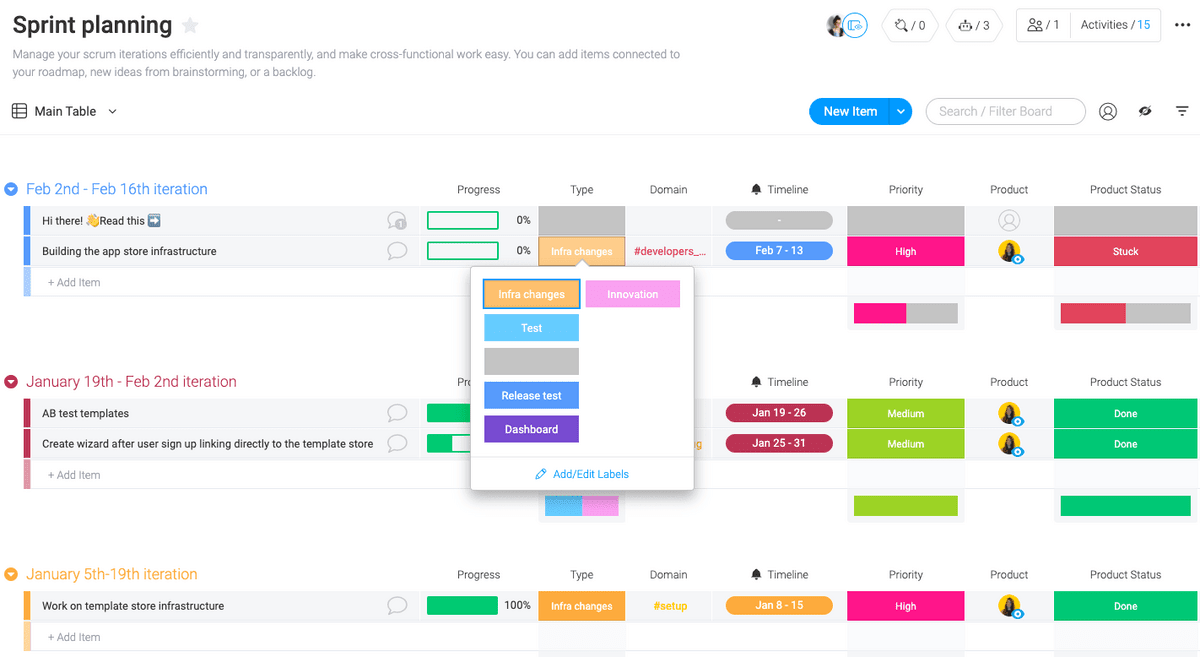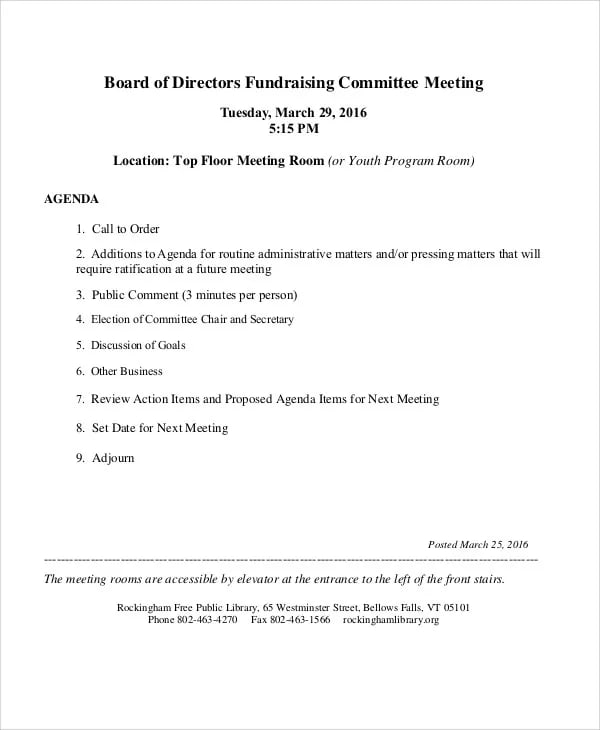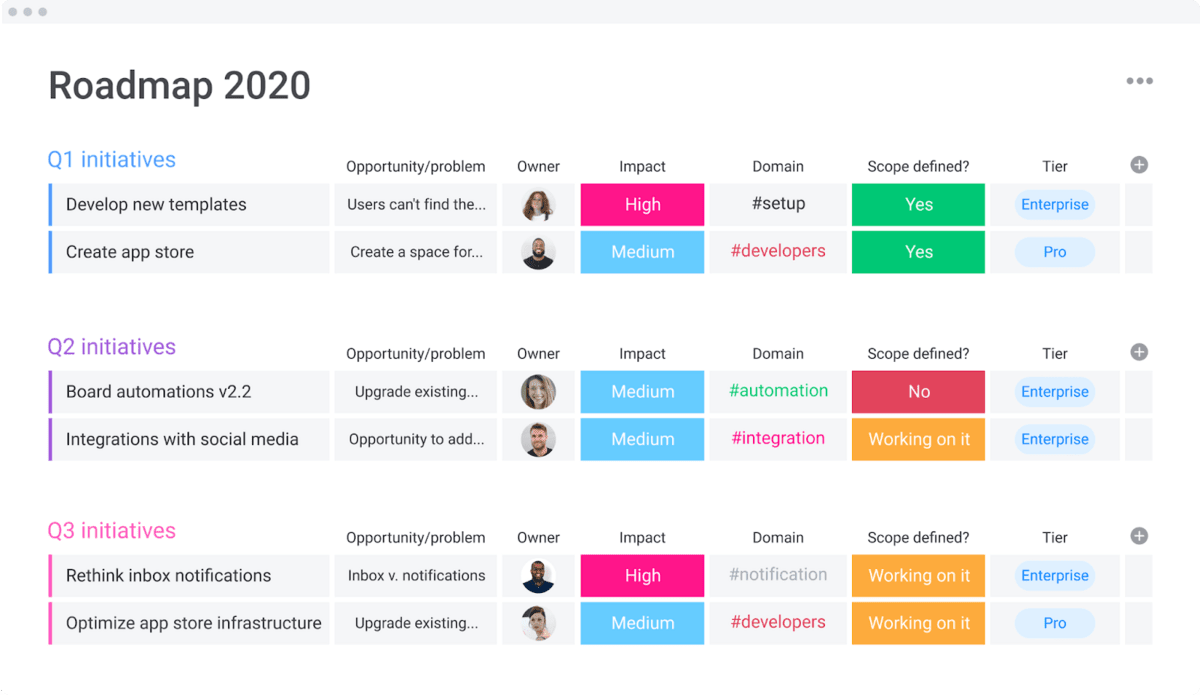Customizable meeting agenda templates
Blog: Monday Project Management Blog
Everyone’s been stuck in an endless meeting that’s completely derailed from its original purpose. Not only does it waste time, but it’s frustrating for everyone involved. Meeting agendas are perfect to avoid those time sinks as much as possible.
In this article, we’ll explore why agendas are so important and share easy-to-use meeting agenda templates you can use to transform your meetings and improve your entire project management process.
CTA to get your template*
What is a meeting agenda template?
Let’s start with the basics — a meeting agenda is a list of points you need to discuss during a meeting. It lists items in the same order you’ll discuss them. So, if you’re presenting a project budget and following it up with discussions about the timeline, those 2 agenda items should be in that order.
Effective meeting agenda templates make planning and writing agendas for your meeting easier. They’re a templatized version of a meeting agenda that teams can customize and repurpose for each meeting.
Screenshot of meeting agenda template
Some agendas will specify how much time to spend on each action item. For instance, meeting organizers may decide to spend no more than 10 minutes discussing resource management while they allocate 20 minutes to going over essential project milestones.
You can use agendas for internal team meetings or board meetings, sure. But, they’re also useful for meeting with external contractors or with customers. To make sure that things go smoothly, give everyone a copy of the meeting agenda.
Why use a meeting agenda template?
Any meeting without an agenda usually devolves into a chit-chat session where the most talkative team members take over — a meeting agenda template can help you run meetings that are actually productive.
Hold productive meetings
Using a clear agenda can reduce wasted time and increase productivity during team meetings since it clarifies exactly what the meeting should be about. Without a meeting agenda, it’s easy for meeting participants to get distracted and go off on a tangent for an entire hour. That’s why meetings often go way longer than they should.
Cover everything, don’t get sidetracked
A clear plan helps meeting participants manage their time and stay on track. Let’s say you’re in a meeting and you’re still discussing the first item 30 minutes in, but you still have 10 more things to cover. The agenda helps move things along and gives each item the attention it deserves. A visual roadmap of the meeting makes it easier for everyone to manage their time.
Prioritize effectively
If different items have completely different levels of importance, it can be helpful to map out how much time to spend on each item. If you know you’ll need 20 minutes to cover the final point, you’ll be less tempted to go over the allotted time for the previous points.
Nail up-front preparation
A meeting agenda is also useful because it helps everyone prepare ahead of time. As long as the entire team gets a copy of it in advance, they can read it over and prepare anything they need to say. Agendas also simplify the taking of meeting notes. The notetaker can separate notes and the list of topics based on the agenda.
Standardize the process with templates
Meeting agenda templates simplify the agenda creation process. With a template, there’s no need to start from scratch every time. With a standard format, it’s also easier to ensure consistency between recurring meetings.
What are some examples of meeting agenda templates?
Let’s explore what type of meeting template you can use to optimize your meetings.
Project kickoff meeting agenda
If you’ve ever worked on a project, you know that the initial planning meetings can quickly veer off course. A project kickoff meeting agenda template ensures all bases are covered so that you start your project off on the right foot. The template should lay out the entire meeting, including covering the project charter, deciding on a rough timeline and budget, and listing key stakeholders

Sprint planning meeting agenda
If you use the scrum methodology, you’ll also need to kick off each sprint with a sprint planning meeting. The right template can align everyone in the same direction and make sure all team members understand their responsibilities.

Fundraising meeting agenda
Another situation in which meeting agendas are valuable is a fundraising meeting. Fundraising efforts can have so many moving pieces that it’s easy to lose track. An agenda should list everything like potential big contributors, different types of fundraising efforts and events, and more.

monday.com’s meeting agenda template
Agenda templates can help you save time and conduct a more effective meeting. But with tools like MS Word, templates can be difficult to customize to your needs or collaborate on as a team.
monday.com is a completely different experience. Start with our easily customizable meeting agenda template that you can quickly adjust for any meeting type. Once you create an agenda, it syncs all changes in real time with the rest of your team. All team members can edit everything using drag and drop, which ensures that everyone’s on the same page about the agenda ahead of time.
Plus, you can easily use our powerful Work OS features — like automated notifications, conditional rules, time tracking, and other task management tools — to unify all information on a project. You can even track meeting minutes by adding an extra column for notes. The notetaker’s notes will then be available for your whole team, no matter their location.
Use this template to create your meeting agenda — then share your meeting agenda by inviting your team members to collaborate on your board.
CTA to get the template
Meeting agenda template tips and tricks
Let’s run through some tips and tricks that you can use when using a meeting agenda.
1. Run daily standup meetings (including remote team members)
If you’re using a daily standup — daily 15-minute meetings at the beginning of the workday to get status updates — you know it’s not always easy to get everyone in the same room at the same time, especially in the post-pandemic business world. And it doesn’t take many missed meetings to start going way off track from your roadmap.

To hold a productive standup meeting, use an interactive work platform like monday.com, where everyone can see and edit the agenda in real time. Team members on the move can even use our mobile app to access the agenda on their phones. No matter where your team members are, you’ll be able to sync up and get everyone on the same page.
2. Use a basic agenda for brainstorming sessions
Brainstorming sessions are supposed to be more open-ended than other meetings. As a result, it’s easy to get lost in a rabbit hole of ideas and get off-track.
An effective agenda template can help guide a brainstorming session and give it some structure. It keeps everyone aligned while providing them with the time they need to develop transformative and innovative ideas.
If you have other meetings, you can schedule time for brainstorming and critical thinking right in the template. You’ll have freedom within your framework and keep the meeting on track.
3. Implement a repeatable framework for recurring meetings
If you have recurring meetings, you can use a meeting agenda template to standardize your process for these meetings. Every time you have this meeting, you can use the same template to plan out specific action items.
A template helps create consistency over time. You’ll get better at planning and executing your meetings if they stay consistent.
4. Follow the same procedure for every meeting
A meeting with an agenda should start with a call to order. This officially begins the meeting — the call to order also tells the person who’s taking the meeting minutes that it’s time to begin the notetaking.
The meeting should also end with an adjournment. This marks the official ending of the meeting. Anything discussed after the adjournment shouldn’t be considered as part of the meeting.
CTA to get your template
FAQs about meeting agendas
What should be on a meeting agenda?
The specifics of your meeting agenda depend on the needs of your meeting — a board meeting will look completely different from a daily sprint meeting.
Here’s a rough approximation of what each agenda should include:
- Call to order
- Meeting goals
- Action items
- Miscellaneous section if there are small topics
- Adjournment
You should also add time allotments for each section and action items.
How do you create a meeting agenda?
There are several ways you can create a meeting agenda. But the easiest way is to start with a customizable template.
If you’re running your business on monday.com Work OS, all you need to do is download your monday.com meeting agenda template. Then, you can customize the template based on your project’s needs since every meeting will be different. And that’s it! Just remember to share your meeting agenda with everyone involved ahead of time.
How do you know if a meeting is effective?
Everyone should aim to make every meeting more effective. This will help you increase productivity and make the most of everyone’s time.
After every meeting, ask the following questions to judge if it was effective:
- Did you go through every action item? Or did you run out of time to cover everything adequately?
- Did you accomplish the meeting goal? If not, what fell short?
- Did you respect the timeline? Or did the meeting take time from another task?
Go over the answers with your team so that everyone is aware of what could be improved next time.
Customized banner CTA*
The post Customizable meeting agenda templates appeared first on monday.com Blog.
Leave a Comment
You must be logged in to post a comment.








